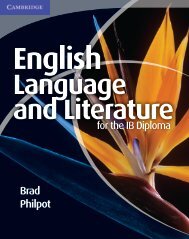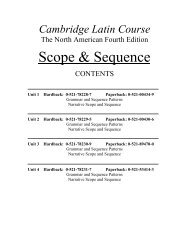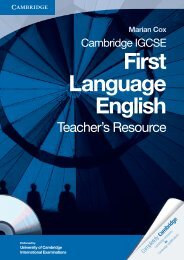6 Answers to end-of-chapter questions - Cambridge University Press
6 Answers to end-of-chapter questions - Cambridge University Press
6 Answers to end-of-chapter questions - Cambridge University Press
Create successful ePaper yourself
Turn your PDF publications into a flip-book with our unique Google optimized e-Paper software.
6 <strong>Answers</strong> <strong>to</strong> <strong>end</strong>-<strong>of</strong>-<strong>chapter</strong> <strong>questions</strong><br />
Multiple choice <strong>questions</strong><br />
1 A [1]<br />
2 C [1]<br />
3 A [1]<br />
4 D [1]<br />
5 B [1]<br />
6 C [1]<br />
7 D [1]<br />
8 A [1]<br />
9 A [1]<br />
10 B [1]<br />
Structured <strong>questions</strong><br />
11 a A – Ventricular sys<strong>to</strong>le [1]<br />
B – Ventricular dias<strong>to</strong>le [1]<br />
b i • Ventricular pressure exceeds atrial pressure [1]<br />
• Atrio-ventricular valve/mitral/bicuspid valve closes [1]<br />
ii • Ventricular pressure exceeds pressure in aorta [1]<br />
• Aortic valve opens [1]<br />
iii • Ventricular pressure is less than pressure in aorta [1]<br />
• Aortic valve closes [1]<br />
iv • Atrial pressure exceeds ventricular pressure [1]<br />
• Atrio-ventricular valve/mitral/bicuspid valve opens [1]<br />
c • Both valves – atrio-ventricular and aortic – are closed [1]<br />
• So no blood is entering or leaving – volume remains<br />
constant [1]<br />
Biology Unit 2 for CAPE ® Examinations Original material © <strong>Cambridge</strong> <strong>University</strong> <strong>Press</strong> 2011 1
d • P wave – represents the wave <strong>of</strong> depolarisation that spreads from<br />
the SA node throughout the atria<br />
• The atria contracts/atrial sys<strong>to</strong>le<br />
• Zero voltage period after P wave – time taken for impulse<br />
<strong>to</strong> travel <strong>to</strong> AV node and Bundle <strong>of</strong> His<br />
• Hence delay in contraction between contraction in atria<br />
and ventricles<br />
• So atria empty completely<br />
• The QRS complex represents ventricular depolarization<br />
that spreads through the right and left side <strong>of</strong> the<br />
ventricles in the Purkyne fibres<br />
• Ventricles contract from apex/upwards<br />
• T wave – repolarisation<br />
e • Closure <strong>of</strong> atrio-ventricular valves – 1st heart sound [1]<br />
• Closure <strong>of</strong> semilunar valves – 2nd heart sound [1]<br />
f • Contraction <strong>of</strong> the ventricle<br />
• While the valves are closed<br />
• AVP: some heart cells/monocytes contract by shortening<br />
or by lengthening or by no change in length<br />
• Heart becomes spheroid in shape<br />
12 a I – left atrium<br />
II – aortic valve<br />
III – heart t<strong>end</strong>ons/chordae t<strong>end</strong>ineae<br />
IV – papillary muscle<br />
V – pulmonary artery<br />
VI – tricuspid valve<br />
b<br />
Each point [1]<br />
Max [4]<br />
Each point [1]<br />
Max [2]<br />
5–6 points [3]<br />
3–4 points [2]<br />
1–2 points [1]<br />
Correct flow [1]<br />
Biology Unit 2 for CAPE ® Examinations Original material © <strong>Cambridge</strong> <strong>University</strong> <strong>Press</strong> 2011 2
c i Atria walls are thin because they pump blood a very short<br />
distance <strong>to</strong> the ventricles [1]<br />
ii Left ventricle is the thickest (three times as thick as the right<br />
ventricle) because:<br />
• has <strong>to</strong> generate pressures up <strong>to</strong> 16 kPa <strong>to</strong> pump blood<br />
<strong>to</strong> rest <strong>of</strong> body/systemic circulation/longer distance<br />
• has <strong>to</strong> overcome resistance <strong>of</strong> systemic circulation that<br />
has arch, branches and resistant walls opposing<br />
pulsation and gravity<br />
• blood in systemic circulation reaches the capillaries at<br />
pressures which would allow efficient exchange <strong>to</strong><br />
materials Any point [1]<br />
iii Right ventricle – not as thick as left ventricle but thicker than<br />
atria because:<br />
• Has <strong>to</strong> generate pressure up <strong>to</strong> 4 kpa <strong>to</strong> pump blood <strong>to</strong><br />
the lungs/shorter distance<br />
• Lungs are delicate air filled alveoli which could<br />
rupture at pressures higher than 4 kpa<br />
• Lungs only have one capillary bed compared <strong>to</strong> systemic<br />
circulation with portal and many capillary beds Any point [1]<br />
d • Internal volume <strong>of</strong> both left and right ventricles is the same<br />
• All the deoxygenated blood leaving the heart on the right<br />
side returns <strong>to</strong> the heart in the left side<br />
• Double circulation<br />
• Any correct answer Any point [1]<br />
e • IV contracts at same time as the ventricles and pulls III [1]<br />
• III pulls down the atrio-ventricular valves and prevent them from<br />
bursting up and opening in<strong>to</strong> the atria under pressure during<br />
contraction <strong>of</strong> ventricles [1]<br />
f i, ii, iii [3]<br />
Biology Unit 2 for CAPE ® Examinations Original material © <strong>Cambridge</strong> <strong>University</strong> <strong>Press</strong> 2011 3<br />
[3]
g • Produces impulses<br />
• Which spreads across atrial wall causing the atria <strong>to</strong><br />
contract<br />
• S<strong>end</strong>s impulses <strong>to</strong> AVN then <strong>to</strong> Bundle <strong>of</strong> His<br />
• Through Purkyne fibres in the left and right side <strong>of</strong><br />
ventricles<br />
• Causing contraction <strong>of</strong> ventricles from apex upwards<br />
13 a • First oxygen molecule combines slowly <strong>to</strong> first haem group<br />
• Thus first part <strong>of</strong> curve is not very steep<br />
• Attachment changes shape <strong>of</strong> haemoglobin (Hb)<br />
molecule<br />
• 2nd and 3rd oxygen molecules attach easily because <strong>of</strong><br />
altered shaped <strong>of</strong> Hb<br />
• Hence curve becomes steeper<br />
• 4th oxygen does not attach easily <strong>to</strong> haem group<br />
• Hence curve flattens<br />
• Any correct answer – cooperative binding/rapid unloading<br />
3–4 points [2]<br />
1–2 points [1]<br />
Any 2 parts <strong>of</strong> the curve<br />
well explained [2]<br />
Any 1 well explained [1]<br />
b i 12 kPa [1]<br />
ii 2 kPa [1]<br />
c Red blood cells:<br />
• No nucleus/few organelles/no mi<strong>to</strong>chondria so more Hb<br />
molecules (250 million molecules)<br />
• Numerous (5 million per mm 3 <strong>of</strong> blood)<br />
• Small size – <strong>to</strong> just fit through narrow capillaries (slowed<br />
down for maximum exchange)<br />
• Large surface area for increased oxygen uptake<br />
• Biconcave <strong>to</strong> reduce size by folding while maintaining<br />
large surface area<br />
• Thin wall – short diffusion path<br />
• Close <strong>to</strong> tissues for diffusion/exchange<br />
• Elastic membrane allows for squeezing through<br />
capillaries<br />
• Has carbonic anhydrase (transport <strong>of</strong> carbon dioxide) Any 2 points [2]<br />
Haemoglobin:<br />
• 250 million molecules <strong>of</strong> Hb per red blood cell<br />
• Contains iron <strong>to</strong> which oxygen binds<br />
• Has 4 polypeptides <strong>to</strong> hold 4 haem groups<br />
• Can carry 4 molecules <strong>of</strong> oxygen per Hb<br />
• Outwardly pointing hydrophilic R groups <strong>to</strong> maintain<br />
solubility<br />
• Cooperative binding <strong>of</strong> oxygen: 1st oxygen added with difficulty,<br />
2nd and 3rd easily and 4th with difficulty/helps with loading and<br />
unloading at various tissues Any 2 points [2]<br />
Biology Unit 2 for CAPE ® Examinations Original material © <strong>Cambridge</strong> <strong>University</strong> <strong>Press</strong> 2011 4
d i<br />
Note that the partial pressure <strong>of</strong> oxygen in an actively respiring muscle<br />
never reaches beyond about 4 kPa. [1]<br />
ii Bohr effect [1]<br />
iii • More oxygen released <strong>to</strong> respiring tissues/less affinity for<br />
oxygen<br />
• Enables more respiration at same partial pressures <strong>of</strong> oxygen Any point [1]<br />
e • Carbon dioxide diffuses in<strong>to</strong> red blood cells<br />
• Carbon dioxide reacts with water <strong>to</strong> give carbonic acid<br />
• Enzyme: carbonic anhydrase<br />
• Carbonic acid dissociates <strong>to</strong> produce H + + HCO3 - ions<br />
• Reduces pH <strong>of</strong> cell<br />
• Hb has higher affinity for H + ions<br />
• Unloads oxygen and picks up H +<br />
• To form HHb/haemoglobinic acid<br />
• Increases pH <strong>of</strong> cell<br />
7–8 points [4]<br />
5–6 points [3]<br />
3–4 points [2]<br />
1–2 points [1]<br />
Biology Unit 2 for CAPE ® Examinations Original material © <strong>Cambridge</strong> <strong>University</strong> <strong>Press</strong> 2011 5
Essay <strong>questions</strong><br />
14 a • Blood flowing under low pressure<br />
• Made up <strong>of</strong> three layers – tunica intima, tunica media,<br />
tunica externa<br />
• Tunica externa – made <strong>of</strong> collagen and some<br />
elastin/largest layer in large veins<br />
• Tunica media – relatively thin, containing smooth muscle<br />
and some elastic fibres<br />
• Tunica intima/<strong>end</strong>othelium – smooth and squamous<br />
• Large lumen<br />
• Semilunar valves<br />
• Thin wall – allows for contraction <strong>of</strong> lumen by skeletal<br />
muscles/low pressure in blood<br />
• Smooth <strong>end</strong>othelium – reduce friction/easier flow <strong>of</strong><br />
blood<br />
• Wide dist<strong>end</strong>ed lumen – accommodates large quantities<br />
<strong>of</strong> blood/acts as blood reservoir<br />
• Valves – prevent back flow <strong>of</strong> blood<br />
• Any correct answer<br />
b • Blood flowing under high pressure<br />
• Tunica adventitia – made up <strong>of</strong> mainly <strong>of</strong> collagen fibres<br />
and some elastic fibres<br />
• Tunica media – thickest <strong>of</strong> three layers/made up <strong>of</strong> elastin<br />
and smooth muscle and some fine collagen fibres<br />
• Tunica intima – has smooth folded <strong>end</strong>othelium<br />
• Collagen fibres – provide main strength<br />
• S<strong>to</strong>p arteries from bursting when pressure is high<br />
• Elastin/elastic fibres – most located close <strong>to</strong> heart<br />
• Elastin – allows expansion <strong>of</strong> lumen without causing<br />
damage<br />
• Keeps pressure high by elastic recoil/s<strong>to</strong>res potential<br />
energy in elastic tissue for subsequent recoil<br />
• Smooth out flow <strong>of</strong> blood/even out surges <strong>of</strong><br />
pressure/maintain flow <strong>of</strong> blood/smooth out large<br />
fluctuations in pressure<br />
• Smooth muscle<br />
• Maintain pressure<br />
• Can contract <strong>to</strong> reduce or increase blood<br />
flow/vasoconstriction/vasodilation<br />
• Narrow/well defined lumen – <strong>to</strong> maintain pressure<br />
• Smooth <strong>end</strong>othelium<br />
• Reduces friction<br />
• Folded – <strong>to</strong> allow for expansion as blood passes<br />
3 structures well described<br />
[2]<br />
3 adaptations [3]<br />
2 structures well described<br />
[1]<br />
3 structures well<br />
described [2]<br />
3 adaptations [3]<br />
2 structures well<br />
described [1]<br />
1 adaptation [1]<br />
Biology Unit 2 for CAPE ® Examinations Original material © <strong>Cambridge</strong> <strong>University</strong> <strong>Press</strong> 2011 6
c • Endothelium is one cell thick – reduces diffusion distance<br />
• Cell is made <strong>of</strong> flattened squamous epithelium – short<br />
diffusion distance<br />
• Smooth <strong>end</strong>othelium – reduces friction<br />
• Pores in the wall between the squamous cells – allows for<br />
faster movement <strong>of</strong> substances and large molecules<br />
• Narrow diameter <strong>of</strong> lumen (8.0 μm) – slows flow <strong>of</strong><br />
blood <strong>to</strong> allow for maximum exchange/short diffusion<br />
distance<br />
• Narrow diameter – allows for red blood cells <strong>to</strong> travel<br />
sideways and singly – slows flow <strong>of</strong> blood <strong>to</strong> allow for<br />
maximum exchange<br />
• Close <strong>to</strong> body cells – allows for faster diffusion<br />
• Large cross-sectional areas – large surface area for<br />
diffusion<br />
15 a i • Pacemaker<br />
• Myogenic<br />
• Produces action potentials that initiate the heart beat<br />
• S<strong>end</strong>s out impulses across atria and <strong>to</strong> AVN<br />
• Causes <strong>of</strong> contraction <strong>of</strong> atria <strong>to</strong>gether and before the<br />
ventricles<br />
ii • Delays impulses <strong>to</strong> ventricles<br />
• Allows ventricles <strong>to</strong> fill/atria <strong>to</strong> fill<br />
• Produces impulses that spreads <strong>to</strong> Purkyne fibres which cause<br />
contraction <strong>of</strong> ventricles Any 2 points [2]<br />
iii • Carries impulses from AVN <strong>to</strong> left and right side <strong>of</strong> the<br />
ventricles [1]<br />
• Causes ventricles <strong>to</strong> contact from base/apex upwards [1]<br />
iv • Papillary muscle contracts at same time as the ventricles and<br />
pulls heart t<strong>end</strong>ons [1]<br />
• Heart t<strong>end</strong>ons pulls down the atrio-ventricular valves and<br />
prevent them from bursting up and opening in<strong>to</strong> the atria<br />
under pressure during contraction <strong>of</strong> ventricles [1]<br />
b i • Blood flows in<strong>to</strong> atria from veins<br />
• From higher pressure in veins <strong>to</strong> lower pressure in<br />
atria<br />
• Since pressure is higher in atria than ventricles, blood<br />
flows in<strong>to</strong> ventricles<br />
• Back flow in<strong>to</strong> veins s<strong>to</strong>pped by valves at base <strong>of</strong> veins<br />
Each point [1]<br />
Max [5]<br />
3–4 points [2]<br />
1–2 points [1]<br />
3–4 points [2]<br />
1–2 points [1]<br />
Biology Unit 2 for CAPE ® Examinations Original material © <strong>Cambridge</strong> <strong>University</strong> <strong>Press</strong> 2011 7
ii • Muscles in ventricles contract in different ways/fibres contract<br />
ios<strong>to</strong>nically or isometrically, pressure increases in ventricles<br />
• Atrio-ventricular valves close <strong>to</strong> prevent back flow <strong>of</strong><br />
blood<br />
• Ventricular pressure exceeds aortic pressure or<br />
pressure in pulmonary artery, semilunar valves open<br />
• Blood flows in<strong>to</strong> the arteries<br />
• <strong>Press</strong>ure decreases in ventricles<br />
• When pressure in ventricles decreases/becomes less<br />
than in arteries, semilunar valves close<br />
• pressure in ventricles becomes less than atria, atrioventricular<br />
valves open Any 2 points well explained [2]<br />
c • Nervous system: stimulation by sympathetic nervous<br />
system/accelera<strong>to</strong>r nerve would speed up heart beat and<br />
force with which cardiac muscle contracts/inhibition by<br />
parasympathetic/vagus nerve slows down heart beat<br />
• Hormones: adrenaline and noradrenaline act directly on<br />
SAN thereby increasing rate and force <strong>of</strong> muscle<br />
contractions and heart rate<br />
• Changes in the volume <strong>of</strong> blood entering the heart<br />
through the veins – if larger volume <strong>of</strong> blood enters the<br />
heart walls and stretches the walls <strong>of</strong> the atria more than<br />
usual, heart rate and force <strong>of</strong> contraction increase<br />
• Any correct answer<br />
16 a i • Pulse rate: number <strong>of</strong> times the heart beats per<br />
minute [1]<br />
• Blood pressure: how hard the heart is working <strong>to</strong><br />
pump blood around the body/force developed by<br />
blood pushing against the walls <strong>of</strong> blood vessels [1]<br />
ii • When the blood is pumped out <strong>of</strong> the heart in<strong>to</strong> the<br />
arteries, the surge <strong>of</strong> blood dist<strong>end</strong>s the arteries<br />
because <strong>of</strong> the elastic tissue<br />
• Stretch and subsequent recoil <strong>of</strong> elastic tissue in aorta<br />
and arteries travels as a wave or pulse<br />
• Hence pulse rate is identical <strong>to</strong> heart rate<br />
b • Heart rate<br />
• Stroke volume<br />
• Age – arteries lose elasticity hence more resistance <strong>to</strong><br />
flow<br />
• Exercise – can cause an increase in heart rate and stroke<br />
volume<br />
• Strength <strong>of</strong> the heart beat<br />
• Resistance <strong>to</strong> flow <strong>of</strong> blood due <strong>to</strong> narrowing <strong>of</strong> blood<br />
vessels/plaque<br />
• Smoking – effect <strong>of</strong> nicotine on arterioles and adrenal<br />
glands/narrowing <strong>of</strong> arterioles and release <strong>of</strong> adrenaline<br />
• Excitement – increase in adrenaline production which<br />
stimulates SAN<br />
• Any correct answer<br />
Each point [1]<br />
Max [3]<br />
Each point [1]<br />
Max [3]<br />
Any point well<br />
explained [1]<br />
Max [5]<br />
Biology Unit 2 for CAPE ® Examinations Original material © <strong>Cambridge</strong> <strong>University</strong> <strong>Press</strong> 2011 8
c • Increased muscle contraction during exercise<br />
• Increased respiration<br />
• Increased carbon dioxide production<br />
• Causes pH <strong>to</strong> decrease<br />
• Detected by chemorecep<strong>to</strong>rs in the carotid and aortic<br />
bodies<br />
• Impulses sent <strong>to</strong> the cardiac accelera<strong>to</strong>r centre (CAC) in<br />
the medulla<br />
• Impulses sent along the accelera<strong>to</strong>r nerve <strong>of</strong> the<br />
sympathetic nervous system<br />
• Noradrenaline released<br />
• Stimulates SAN<br />
• Causes heart rate <strong>to</strong> increase<br />
9–10 points [5]<br />
7–8 points [4]<br />
5–6 points [3]<br />
3–4 points [2]<br />
1–2 points [1]<br />
Biology Unit 2 for CAPE ® Examinations Original material © <strong>Cambridge</strong> <strong>University</strong> <strong>Press</strong> 2011 9








